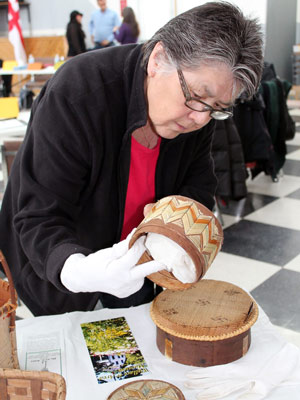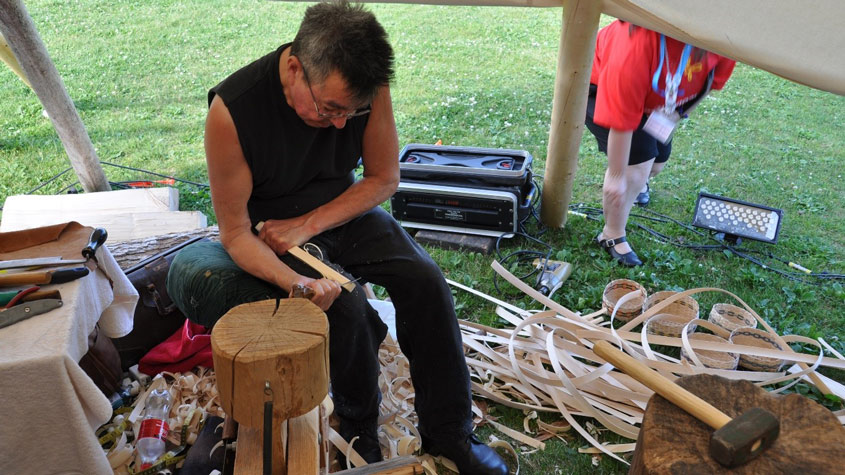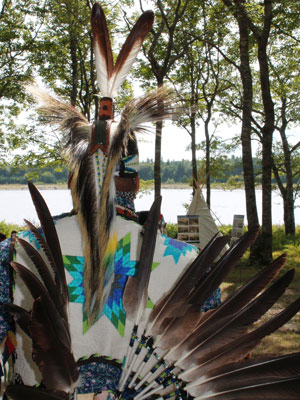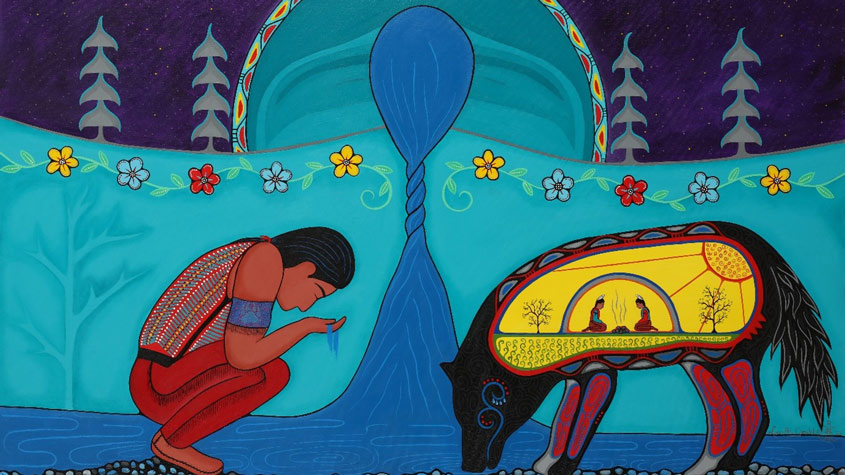

By Anna Sinkevich, Traditional Knowledge Division, WIPO
Shannon Monk, an Indigenous (Mi’kmaw / Anishininew) woman from Canada, has vast experience working with First Nations communities, mainly in the field of cultural education and governance. She is currently working on the implementation of the Cultural Tourism Strategy for the Mi’kmaq of Nova Scotia. Monk believes that cultural tourism is a natural opportunity for Indigenous peoples in Canada to reclaim their cultural heritage. The Mi’kmaq are in the process of reclaiming and redefining their cultural identity and are using IP to support this.

Tell us about the Mi’kmaw Nation.
The Mi’kmaw people are the original people of Mi’kma’ki – the land of the Mi’kmaq. Their traditional lands extend from the provinces of Nova Scotia, Prince Edward Island, and New Brunswick to Newfoundland and Labrador. Mi’kma’ki also extends into parts of Quebec and along the Eastern seaboard of the United States. I always begin by explaining this because the boundaries of the lands belonging to so many Indigenous peoples across Canada and around the world have been impacted by their colonial past. Our brothers’ and sisters’ traditional territories extend beyond the borders imposed by colonisation.
Mi’kmaq are strongly community-oriented and are known as a very warm, friendly, and welcoming people. In the 1700s, the Mi’kmaq engaged in a series of Peace and Friendship Treaties with the immigrants to this land. Those treaties were based on the concept of sharing land and resources in peace and friendship.
Over the last 20 years, there has been a big shift towards supporting the economic development and self-sufficiency of the Mi’kmaw people.
However, the enactment of the Indian Act of 1876 deprived Indigenous peoples of access to their land and First Nations people were put on reserves. So began a more modern system of oppression that took away our peoples’ rights, access to their lands, and to their traditional way of living. For many years, during the colonial period, it was illegal to practice our language and our cultural traditions. Many of our communities have been socially and economically disadvantaged from more than 150 years of colonial rule.
Thankfully, over the last 20 years, there has been a big shift towards supporting the economic development and self-sufficiency of the Mi’kmaw people. Despite the many challenges we face, many people still speak our language, and those who are land-based continue to hunt, fish, and gather natural ingredients for traditional medicine. We are still here, and we are vibrant. But it is a struggle. Many Mi’kmaw communities are still in the process of reclaiming their culture.

How did the idea of developing Mi’kmaw cultural tourism in Nova Scotia come about?
The conversation around cultural tourism began around 20 years ago. There have been highs and lows. In 2016, the Assembly of Nova Scotia Mi’kmaw Chiefs supported the development of a cultural tourism strategy and that gave things a real impetus. The Strategy was adopted in 2019, and I was hired in 2020, to advance its development and implementation.
The strategy is important because the province of Nova Scotia derives its economic sustainability and success almost entirely from tourism. Tourism is our number one economic generator. People from all over the world visit Nova Scotia; it’s a really beautiful spot with great access to nature, wildlife and beaches. Probably one of the most important reasons why people come here is because they feel safe among people who are friendly and welcoming.
Redefining what is means to be “authentically” Mi’kmaq is a key part of reclaiming our culture.
Five centuries ago, rather than waging war, the Mi’kmaw people welcomed newcomers to their country, offering them peace, friendship, and hospitality, but gained little in return. Indeed, our communities suffered under oppressive laws. Having emerged from these dark times, we are now able to be uniquely ourselves. This is an important part of reclaiming our cultural heritage. Once again, in our age-old way, we are welcoming the world to our territory. The difference is that today, we are shining a light on who our people are and we’re ensuring our communities enjoy the economic benefits of cultural tourism.
Tell us more about the cultural tourism strategy.
The cultural tourism strategy includes four pillars: first, governance and leadership development; second, authenticity; third, product development; and fourth, marketing. Authenticity lies at the heart of the strategy. Educating our communities about tourism and building awareness about the opportunities it can offer them are also important. In talking to our people about cultural tourism, they often tell us, “Well, that’s not me. I’m just a crafter. I’m just an artist. I just gather medicines”. There is always that qualifier, “I’m just this or that”. They don’t necessarily see their connection as a Mi’kmaw person with cultural tourism or the opportunity it offers them to represent the Mi’kmaw nation. So that is why these pillars are so important – ensuring that we proceed with a Nation-based approach that emphasizes our authentic culture and encourages equitable participation in the tourism economy.

of the bark of ash and birch trees in their basket-making
skills. Quills from porcupines are also often used to create
intricate patterns. It is painstaking work. The quills are
often dyed to produce colour variations and visual interest.
This ancient custom is still practised today and passed on
to family members. (Photo: Kwilmu’kw Maw-klusuaqn)
What cultural values does the cultural tourism strategy seek to promote and protect?
The number one value is authenticity. As there has been so much cultural erosion over the centuries, redefining what is means to be “authentically” Mi’kmaq is a key part of reclaiming our culture. And that process also includes how we address cultural appropriation; how we set the boundaries between what is authentically Mi’kmaq and what is not, and how we deal with people who are not authentically Mi’kmaq but who may be using Mi’kmaq images, symbols, and other cultural expressions.
What elements of your culture do you consider to be authentically Mi’kmaq?
Our petroglyphs found at our different sacred sites, our koju’a dance, the ji’kmaqn musical instrument and our waltes game are examples of what is undeniably “authentically” Mi’kmaq.
How will your community benefit from cultural tourism?
Cultural tourism has economic benefits. It is a way to make a sustainable living. But for us, it is also an opportunity to reclaim our culture, re-build our identity and confidence, and to establish stronger communities of people who are motivated and excited to learn about their culture, traditions, and languages. In this process, we are also hoping to celebrate the artisans within our communities and to promote their work. As an example, one of our communities in Eskasoni has established Cultural Journeys – an immersive cultural experience with trails wending around a cultural village. Visitors can walk along the trail, and visit different stations where they can learn about Mi’kmaw history, experience traditional songs, drumming and dancing, and try traditional food.
Cultural tourism […] is an opportunity to reclaim our culture, re-build our identity and confidence …
What are you seeking to achieve through cultural tourism?
This work is about ensuring that Mi’kmaw people have greater ownership and control over their stories, products, and services. When you come to Canada, in most airports, you’ll see many trinkets adorned with feathers and beads. They look like they are Indigenous made, but they are not authentic and are a poor representation of the real thing. Part of our goal is to address such cultural appropriation and ensure that our communities have greater control over and benefit economically from our cultural expressions. We want to address how our cultural products are exploited, while at the same time, ensuring consumers can buy the “real thing.”
From a governance perspective, we would also like to see the establishment of a Cultural Tourism Department that is run by the Mi’kmaw people.

How did you come to create the logo for the Mi’kmaw cultural tourism brand?
Our aim is to develop a logo that people recognize and trust, confident that the product or service they’re buying is authentically Mi’kmaq. The logo and the brand will be used exclusively by members of the Mi’kmaw Nation. These important assets will be protected as both a regular trademark and as an official mark of the Mi’kmaq in Nova Scotia under the guidance and endorsement of our Chiefs. We filed our trademark application with the help of a pro bono lawyer offered by the International Trademark Association (INTA) as part of the WIPO Training, Mentoring and Matchmaking Program on Intellectual Property for Women Entrepreneurs from Indigenous Peoples and Local Communities, in which I participated in 2021.
In developing our brand and its logo, rather than hiring some random graphic designer, it was important for us to go to the community. We needed to lay a foundation of authenticity from the outset. When I say “we”, I mean with the endorsement of the Chiefs and community members, because our protocol requires that we always go back to our leaders and communities for their approval.
Our aim is to develop a logo that people recognize and trust, confident that the product or service they’re buying is authentically Mi’kmaq.
To set the process in motion, we sent out a notice to our communities inviting them to submit proposals for a new logo. We received submissions from ten artists. The Chiefs selected two, a man and a woman, to represent gender balance, which is important in Mi’kmaw culture. The Chiefs also wanted to make sure we had geographic representation with someone from the North (Cape Breton Island) and from the South (the mainland), to ensure all communities were represented. The artists selected, Loretta Gould and Alan Syliboy, began collaborating on several designs. We also brought in our in-house Mi’kmaw graphic designer to work with them to ensure the logo met trademark requirements and parameters while respecting the integrity of their work.
The whole process, which took around six months, was rather intense because different parties – the artists, the graphic designer, the Chiefs, and the community – had different ideas about what the logo should look like. However, after much back and forth, we came up with a design that everyone agreed on. We really wanted to take our time to get it right because we knew from the outset that our trademark was going to be international, and we wanted our people to be proud of it.

During a mawiomi, people come together to dance,
visit, share stories, and pray. Dance is considered
a form of ceremony, prayer, and healing. Regalia today
is made with both ancestral and modern materials.
Different types of regalia are created for various dance
styles and, as in this photo, can reflect influences from
different nations. (Photo: Kwilmu’kw Maw-klusuaqn)
What were the main challenges you faced in creating the logo?
Ensuring that everyone felt they had an opportunity to participate in the process – and within a reasonable timeframe – was a big challenge. But this was essential given our aim is to build a brand that evokes a sense of community, authenticity and welcome; a brand that inspires community members to become cultural ambassadors for the Mi’kmaw Nation. The exercise goes far beyond ticking a box and setting up a specified number of businesses. There was certainly a tension between the need to secure community “buy-in” on the one hand, and to achieve that within the timeframe expected by our funders, on the other hand. When the priorities of funders and government are out of step with those of the Mi’kmaw communities, things can get a little tough. But everyone worked really well together to achieve our goal.
How do intellectual property (IP) rights fit into Mi’kmaw community values?
Raising IP awareness within Mi’kmaw communities is an ongoing education process. Community leaders are typically familiar with IP rights, but in general, people within the community don’t really talk about IP or see that it is relevant to their daily lives. Over the last two and half years, we’ve approached IP in terms of the value of “authenticity.” It takes time to build awareness and understanding of these issues within the community.
Raising IP awareness within Mi’kmaw communities is an ongoing education process.
One of the big challenges has been how to handle the collective versus the individual IP. We know there are no strong IP mechanisms in place to support collective rights. The main concern we hear within our communities is that non-Mi’kmaw people are taking elements of Mi’kmaw culture to create products and sell them. The source of the problem is that we don’t have any legal way to say, “Hey, you shouldn’t do that!”
When we finalize the registration of our trademark, the Mi’kmaw communities will be better placed to sell these cultural goods to a broader market and to expand their support network. Of course, those opportunities also need to be balanced against the responsibility that community members have towards the Mi’kmaw Nation. These responsibilities include a commitment to uphold the values and principles of the Mi’kmaw Nation, including a commitment to learn what it means to be authentically Mi’kmaw. In light of this, we are planning various workshops to enable community members to acquire the skills they need to build and manage the Mi’kmaw brand as a mark of authenticity.

When we finalize the registration of our trademark, the Mi’kmaw communities will be better placed to sell these cultural goods to a broader market and to expand their support network.
What are your next steps?
We’ve created an IP Guide. We sent it out to communities to get their feedback and now it’s available as a resource. It is currently being translated into the Mi’kmaw language. We are also developing a toolkit for entrepreneurs interested in starting a cultural tourism business. It outlines all the business development resources available in Nova Scotia as well as various cultural elements to create awareness of the need for authenticity and the challenges of cultural appropriation.
What advice do you have for young Indigenous entrepreneurs?
First, be proud of your culture and of who you are. While there have been huge challenges around Indigenous identity for many years, we are now seeing a positive shift, which offers a perfect opportunity to build our cultural identity.
Second, I recommend that young people and entrepreneurs visit their elders, communities, and knowledge keepers, spend time with them and learn as much as they can. There are many resources to start businesses, but first you need to have that cultural foundation and community. According to our teachings, each of us carries a responsibility to do whatever we can to create the best opportunity for our future seven generations. That connection with the community, the elders and our traditional knowledge is critical to each of us as individuals, and to the survival of our communities.
I urge young people to learn about IP and explore how it can protect and add value to their work. IP rights can play a critical role in defending their interests against cultural appropriation.
Third, I also urge young people to learn about IP and explore how it can protect and add value to their work. IP rights can play a critical role in defending their interests against cultural appropriation.
And, finally, I urge young Indigenous people to join ranks and to support the work that’s being done to protect the collective rights of communities. So much more still needs to be done to protect them.
<!–

–>
The WIPO Indigenous Peoples and Local Communities Women Entrepreneurship Program
The WIPO Training, Mentoring and Matchmaking Program on Intellectual Property for Women Entrepreneurs from Indigenous Peoples and Local Communities (WEP) aims to encourage women entrepreneurship, innovation and creativity related to traditional knowledge and traditional cultural expressions. It seeks to equip these women entrepreneurs with the knowledge and skills to make strategic and effective use of intellectual property rights in support of their communities’ entrepreneurial activities.
Since its launch in 2019, the program has supported over 100 women entrepreneurs from Indigenous and local communities from 63 countries.
- SEO Powered Content & PR Distribution. Get Amplified Today.
- PlatoData.Network Vertical Generative Ai. Empower Yourself. Access Here.
- PlatoAiStream. Web3 Intelligence. Knowledge Amplified. Access Here.
- PlatoESG. Carbon, CleanTech, Energy, Environment, Solar, Waste Management. Access Here.
- PlatoHealth. Biotech and Clinical Trials Intelligence. Access Here.
- Source: https://www.wipo.int/wipo_magazine/en/2023/04/article_0002.html



